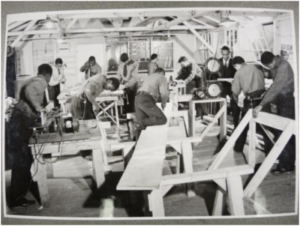
CCC men at woodworking shop in Cabin John, Maryland
The CCC offered African American enrollees the opportunity to learn a trade.
Both friends and critics of the New Deal point to actions by President Franklin Roosevelt and the exclusion of African Americans from some programs as evidence that the New Deal was racist. But in order to evaluate the New Deal fairly we have to ask what the country was like at the time.
While the New Deal revolutionized many aspects of society and government, it was not able to overcome America’s entrenched racial order. The fact is, the United States had been a white supremacist country from the beginning—rife with genocide and suppression of native people; slavery followed by Jim Crow; and the exploitation and exclusion of Chinese, Mexicans, and Filipinos. That was the world the New Deal inherited. The Civil Rights Movement would not arrive for another generation.
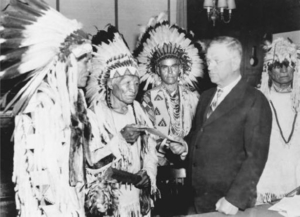
Indian New Deal
Secretary of the Interior Harold L. Ickes hands the first constitution issued under the Indian Reorganization Act to delegates of the Confederated Tribes of the Flathead Indian Reservation, Montana, 1935.
Photo Credit: Courtesy Library of Congress, Prints and Photographs Division
The New Dealers faced the daunting task of overcoming long-established patterns of discrimination and social hierarchy. They did not challenge the prevailing racial order head-on, but that’s not the same as saying it was racist. The leading New Dealers—Eleanor Roosevelt, Harold Ickes, Frances Perkins, and Harry Hopkins—were outspoken critics of racial discrimination and made a systematic effort to include people of color in New Deal programs. Their overall achievement was impressive, if far from perfect.
Most New Deal programs reached out to include Native Americans, African Americans, Latinos, and Asians to an unprecedented degree. People of color worked in large numbers in all the big relief programs and there were education, recreation, and health programs aimed specifically at helping them.
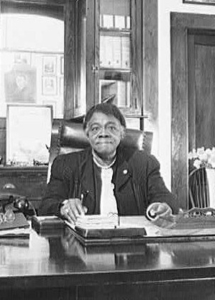
Mary McLeod Bethune, 1943
An educator, author and civil rights advocate, and advisor to FDR and First Lady Eleanor Roosevelt, she headed the Negro Division of the National Youth Administration.
Photo Credit: Picyrl
For example, the Indian Reorganization Act of 1934, the so-called “Indian New Deal,” was a radical shift in federal policy. It was a genuine effort to honor native sovereignty, improve reservation lands, promote artisan crafts, and build schools for native children. On the other hand, the Bonneville and Grand Coulee dams built on the Columbia River flooded thousands of acres of Native American lands without even providing irrigation water to local reservations.
Other New Deal achievements baked in discriminatory policies. The Social Security and National Labor Relations Acts of 1935 made an exception for agricultural and domestic workers, effectively excluding African Americans and Chicanos as a result of compromises FDR made with Southern Democrats and Western Growers to get these programs through Congress.
Nevertheless, FDR put African Americans into positions of power not seen since Reconstruction. A group of prominent African Americans were popularly known as FDR’s Black Cabinet. They included Lawrence Oxley, a high-ranking official in the Department of Labor; Mary McLeod Bethune, the director of the National Youth Administration’s Office of Negro Affairs; and Robert Weaver, who served as an economic advisor to the president. FDR also appointed William Hastie as the first-ever African-American federal judge.
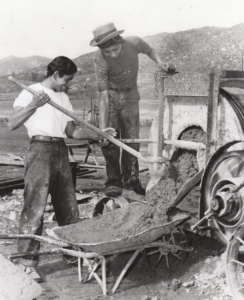
Men at work
The Farm Security Administration established camps for migrant farm workers in California, and the CCC and WPA hired unemployed Mexican Americans on relief jobs.
By Executive Order, discrimination was barred in the relief agencies and workers were paid equal wages regardless of race nearly everywhere. The WPA employed hundreds of thousands of African-American, Asian, Mexican, and Native American citizens. These were not only men doing manual labor. Women of color were hired as teachers, social workers, librarians, and in other professional and service sectors, often working on integrated teams.
The Civilian Conservation Corps (CCC) is often cited as a segregated program, but at the outset it was integrated. Intense opposition in rural areas of the North and across the South ultimately forced the CCC to segregate its camps.
The New Deal ended President Hoover’s aggressive deportation of Mexicans and invested heavily in Puerto Rico, the Virgin Islands, and Hawai’i. Yet, President Roosevelt made a catastrophically bad decision to issue Executive Order 9066, which imprisoned some 120,000 innocent Japanese Americans as the country went to war at the end of 1942.
While the New Deal fell far short of ending racial discrimination, it set in motion the forces that would challenge Jim Crow in the postwar era. The number of people of color working for the federal government increased dramatically during the New Deal and many were elevated to important positions in government. Many of the black leaders Roosevelt relied upon would go on to help launch the Civil Rights Movement. Integration of the Armed Forces would begin by the end of World War II. Supreme Court justices appointed by FDR were crucial to postwar judgments against segregated education, anti-miscegenation laws, and housing discrimination.
The New Deal marked an important step forward in addressing the problems of U.S. society. Its outlook, policies, and programs, while far from perfect, contributed to the advancement of millions of citizens of color as part of its massive effort to improve the lives of all working people, seniors, children and other ordinary Americans.

FDR’s "Black Cabinet"
An informal cabinet of African Americans served as public policy advisors to President Franklin D. Roosevelt and First Lady Eleanor Roosevelt,. Front row, left to right: Dr. Ambrose Caliver, Dr. Roscoe C. Brown, Dr. Robert C. Weaver, Joseph H. Evans, Dr. Frank Horne, Mary McLeod Bethune, Lt. Lawrence A. Oxley, Dr. William J. Thompkins, Charles E. Hall, William I. Houston, Ralph E. Mizelle. Back row, left to right: Dewey R. Jones, Edgar Brown, J. Parker Prescott, Edward H. Lawson, Jr., Arthur Weiseger, Alfred Edgar Smith, Henry A. Hunt, John W. Whitten, Joseph R. Houchins. Source: Scurlock Studio, “President Franklin D. Roosevelt’s “Black Cabinet” taken in March 1938″
Photo Credit: Wikipedia
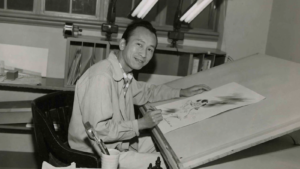

Great job, DW!
Thanks for taking on this issue, Richard. Eleanor Roosevelt confronted societal racism head-on when she created the first New Deal planned community, Arthurdale. She was determined that Arthurdale, a resettlement project for destitute West Virginia coal miners, would be integrated, but she ran up against an impossible barrier. White coal miners refused to move to Arthurdale if there were to be black miners settled among them. It was an experience which deepened her commitment to civil rights.
The Federal Theatre also attempted, and often succeeded, in breaking racial barriers. They insisted on integrated audiences, and cancelled some shows when they were refused. They also, famously, produced shows involving black actors in real roles, rather than relegating them to stereotyped parts as mammies and comic relief. Most famous among them was Voodoo Macbeth, the Orson Welles all-black production of Macbeth, but there were many others, including a hilarious (and controversial) production of Lysistrata on the West Coast, and an all-black Mikado that had many imitators. More controversial were the shows with integrated casts. When Martin Dies of HUAC went after the Federal Theatre, he took testimony from a white woman who reported that a black cast member had asked her out on a date. This was used to prove that the Federal Theatre was a subversive and probably Communist undertaking.
I think there is an opportunity for someone to do more in depth research about the New Deal’s successes and failures in attempts to battle the deeply ingrained prejudices of the time.
Susan Quinn, author of Eleanor and Hick: The Love Affair That Shaped a First Lady and Furious Improvisation: How the WPA and a Cast of Thousands Made High Art Out of Desperate Times.
Thank you for setting the historical record straight.
I get so disgusted by today’s identity politics advocates who know so little history and are so eager to view an issue through a single identity based lens. There are many who are using this false history to attack the nascent New Green Deal, which makes this an even more serious problem.
Once again, thanks and lets hope this word gets spread more broadly.
PS how do I tweet this essay?
To say you need to understand how the country was like at the time is saying racism is fine if the majority was then racist.
Racism is racism and should not acceptable, ever!
Of course, racism is not acceptable any time and this country has a dark history. But do we simply write off everything in the past because of that? We have to put ourselves back in time and make judgements about who and what strengthened white supremacy or worked against it. The same goes for our very imperfect present.
What I find interesting is how this article repeatedly suggestion good intention only to have the Roosevelt administration ultimately implement highly racist policies. We need to understant that Roosevelt, himself, was a white supremacist who aided Woodrow Wilson to segregate the military and the Executive Branch in Washington. FDR professed a belief that it was unnatural for Chinese and Caucasians to mate and that any offspring would be “unfortunate.” When running for governor of New York, he ordered his staff to prevent any photos with Black folks. He had no problem in sending Japanese Americans to concentration camps but told the white Italian and German communities that he would not do that to them even though we were also at war with them. The spa in Warm Springs, Georgia where he died was segregated and would not allow Black children to the claimed benefit of the healing waters. It was not the zeitgeist of the times, because FDR OWNED spa — having purchased it in 1927 — six years before his presidency. The main architect of the New Deal was Hugo Black — a one-time member of the KKK. The entire New Deal was crafted by southern racists in order to transfer jobs away from Blacks to whites. Before the crash, Black and White unemployment were approximately equal — but the New Deal results in a rise of white unemployment to 17 percent and Black unemployment to 50 percent. The head of the NAACP called the National Recovery Act (NRA) the Negro Riddance Act. The article mentions the work on dams. The Bolder (Hoover) dam project had some 25,000 workers. The best counts showed 25 Blacks. In other work environments, Blacks were house in inferior camps. When the TVA was construction, whites were compensated for lost land and lost jobs. Blacks were not. There was great frustration within the Black Cabinet because many believed that they were being used as window dressing. In fact, it is hard to find any recommendations that were implemented by FDR, Congressional Republicans offered up anti-lynching legislation on two or three occasions — only to have it opposed and defeated by Roosevelt and congressional Democrats. This just a snippet of the racism of Roosevelt and his powerful southern Democrat allies. FDR was not a victim of the racial attitudes of the times — especially in the south — but a full supporter and participant. Now … it can be said the Eleanor Roosevelt did not share her husbands racial views. Black leaders often went to her to intervene with the President. Whether she did or not is unknown, but there were not positive responses to their pleas. I have spent 10 years researching the racial history of America — and the Democratic Party does not look very good even to this day if you look at the facts … not the narrastives..
Larry,
FDR has a checkered record on race, to be sure, but calling him a White Supremacist is over the top. Hugo Black was, indeed, in the KKK but he sure changed over time and became one of the most progressive Supreme Court justices ever (the same could be said for Earl Warren, btw). In any case, the New Deal is not identical to FDR or Hugo Black.
To say that “the whole New Deal was crafted by Southern racists” is wildly exaggerated, even though the South had a huge influence in several ways: the make-up of the Democratic Party of the time; the power of Southerners in Congress; a number of southerners in key posts in the administration; and the manipulation of federal policies at the state and local level in the South. But just how was the New Deal supposed to eliminate the power of the South and who else had even tried before 1933? It took the collapse of King Cotton, mass black emigration, and the Civil Rights movement to budge the South into the 20th century, and, as you have surely noticed, the base of the Republican Party is now solidly in a by no means reconstructed South.
To blame the greater unemployment of Blacks in the Great Depression on the New Deal is absurd. It is true that the early New Deal (FERA, NIRA, CCC) were not very helpful to African Americans, but that changed dramatically over the course of the 1930s, which ended with the WPA, CCC, NYA and PWA hiring almost two million Black people. Not surprisingly, Black folks ended up voting overwhelmingly for FDR in 1936 and 1940. I presume they were not simply deluded.
This is an important debate, but we have to be fair and avoid sweeping denunciations without enough evidence.
Richard A Walker
The New Deal was extremely racist providing mortgage guarantees to white Americans, denying the same guarantees for blacks. It also created segregated public housing projects basically creating today’s ghettos. To say New Deal politics were not racist because blacks benefited or some black causes were championed is being disingenuous and insulting. The truth is, New Deal Politics were very racist and damaging. Richard Rothstein in his book, “The Color of Law”, illustrates the high degree of racist practices of the New Deal housing policy and its effects on the neighborhoods of America today.
Germile, No, our view on race and the New Deal is neither disingenuous nor insulting. The truth is that the New Deal did some real harm but also quite a bit of good for African Americans, and it did so at a time when this country was profoundly racist and Jim Crow. We can debate the pros and cons, but writing it off as wholly racist is wrong – and goes against what every historian of the New Deal and African Americans says, even as they rightly criticize many of the New Deal’s programs.
It is simply not true that the New Deal created segregation and today’s ghettoes. Those go back to before 1900 and White people were segregating themselves through deed covenants, suburbanization and zoning long before 1933. And you might note that White people are still segregating themselves despite the Civil Rights Act, Fair Housing Act and all sorts of court decisions against segregation. So, even the Civil Right movement did end housing segregation and we today can hardly be holier-than-thou in judging the past.
It is true that most New Deal public housing was segregated, but that is because Whites in every city opposed housing integration and even all-Black public housing, and they mobilized local government, state politicians and white mobs to get what they wanted. Remember, there was NO public housing anywhere but New York City, white or black, before the New Deal. Getting any New Housing for African Americans in the 1930s was a struggle, and the New Deal succeeded in building quite a bit.
As for the HOLC and FHA mortgage programs to support homeownership, they were enlisted by White economists, realtors and developers to write ‘red-lining’ into the administrative rules (it’s not in those laws). The effects of that for Black Americans were terrible. Yet, those programs aided millions of White homeowners during the Depression and after WW2. Unfortunately, those working-class Whites also wanted nothing to do with integration, and they fought it tooth and nail. So is the New Deal to blame or, rather, the long history of White Supremacy in this country?
Richard Rothstein’s book is very bad history, in which he distorts the evidence and fails to either look at the history of segregation before the New Deal or the powerful White opposition to integration for decades. He ends up blaming government for a problem that runs deep in the American society.
FDR’s crowning racial achievement that you casually omit – the incarceration in concentration camps of 125k American citizens of Japanese heritage, makes FDR the closest this country has flirted with fascism.
No, that is not ‘casually omitted’. The WWII internment camps were a wartime act and not really part of the New Deal. That Executive Order was undoubtedly FDR’s worst decision and is quite indefensible. It was driven by a combination of wartime hysteria and long-standing anti-Japanese racism, especially in California. Eleanor Roosevelt and Harold Ickes both opposed it strongly and publicly, but FDR bowed to the military and local racist opinion. It should be noted that the New Deal and FDR are not identical and we are well aware that Roosevelt was an imperfect man and calculating politician, as well as a great president, and not simply a hero to be adulated.
Hi Richard, in regards to this topic, my friends wrote an article that is unfortunately lost about the Human Betterment Foundation out of Caltech set up in 1928 by Ezra S. Gosney and Paul Popenoe that was the West coast version of Cold Harbor NY in the research of Eugenics, sterilization, and similar disgusting policies. All the race laws designed around “curbing defectives” that were utilized by the Nazis to sterilize or euthanize the unfit as a cost cutting measure came out of these Socal organizations. No surprise that the Japanese Internment Camps came about as a result of these gentlemen. At the time “the number of non-“Aryans” sterilized in California was higher than their respective proportion of the total population of the state. African-American inhabitants over 21 years of age made up 1.5% of the 1930 state population, but comprised 4% of the total sterilized. Some 20% of the men and 11 % of the women sterilized were not U . S. citizens, with the proportion of Latin races being particularly high. According to California’s eugenicists, “Mexican-Indian stock … showed an average of intelligence lower than that of the American Negro” according to Paul Popenoe and Roswell Hill Johnson, Applied Eugenics, p. 294. Macmillan Company, New York, 1933. Unfortunately, this mental disease was not confined to the 1920’s as the same characters showed up in the mid 1990’s with the anti-immigrant Proposition 187 legislation.
Indeed, California was the world center of Eugenics in the early 20th century, with several key figures in the movement such as Stanford President David Starr Jordan and Frederick Terman (Sr), who invented the IQ test in part to vet Mexican immigrants. But the anti-Japanese racism of the time that led up to the Internment of WW2 was driven by economic considerations, such as competition with white farmers in the state and business rivalry with Japan in the Pacific basin.
Ya’ll are crazy as heck. As has been mentioned, FDR was a bigot, sure, but “The New Deal” was the collectively designed and enacted project of THOUSANDS of people. Many of those people were Black or Latino themselves, many more were militantly anti-racist at a time when being so didn’t just mean tweeting your support as a BLM ally or however bourgeois whites virtue signal nowadays. With the possible exception of those living in parts of NYC, segregation’s vile logic worked on both sides. To be a white, outspoken opponent of racism in 1930 had social consequences, up to and including violence.
By claiming that the New Deal project (again – not FDR, not individuals in the administration) was not just flawed but racist, you do a great disservice to all those who fought for new deal programs to do the (insufficient) good they managed to do for minorities… A disservice to the millions of Blacks and others who switched to the Democratic Party because THEY apparently thought the new deal benefited their communities in real time… AND finally a disservice to yourself and all of us here in the present. Because I don’t know if you’ve noticed this, but there’s a generations-long effort to roll back the new deal and convince working people that there’s nothing they can or should expect from any gov’t program that’s going to help them. That the ONLY way their lives get any better is by lowering their bosses’ taxes so that maybe he’ll pass it on rather than moving to Vietnam or Texas. And as far as I can tell, it hasn’t left ANY regular working folks, of ANY color, in a better position than they would have been a generation ago, before deindustrialization, the explosion of the financial sector, and the downfall of the labor movement left most working people punch-drunk and barely hanging on. For people to be looking at one of the only attempts to make America run like a society – rather than a collection of individuals trying to undercut their neighbors and get over at all costs – and ATTACKING it is just truly bonkers to me